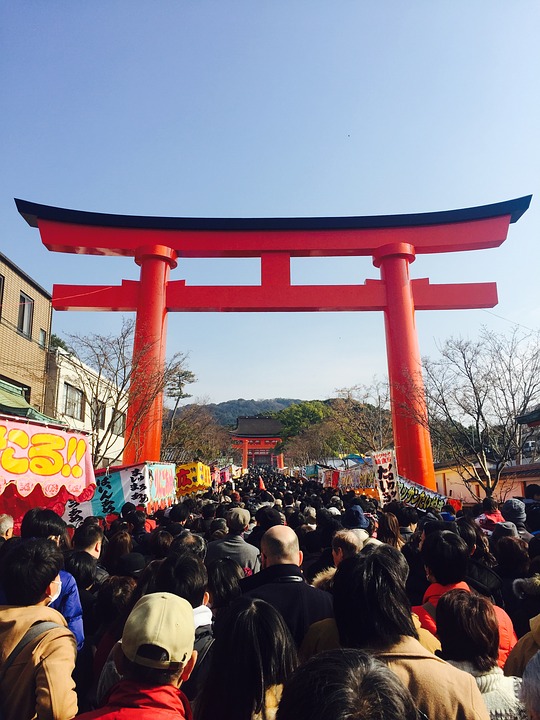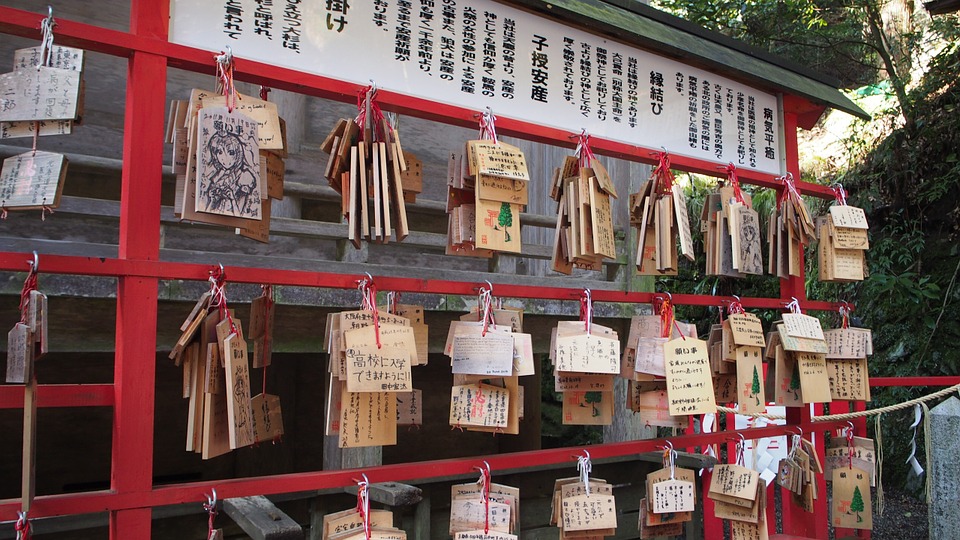Traditions exist all over the world, with different variants and iterations of it shared across different cultures. For example, many areas celebrate Halloween, Christmas, Birthdays, and Valentine’s Day. The nuances of how they are celebrated, however, are often different.
During New Year’s, many people come together to celebrate a cycle of the earth making an entire revolution around the sun. Some enjoy themselves by drinking the night away, others get together with family, light decorations, or go about traditions brought on by their religions and/or personal beliefs. In Japan, one of those New Year’s traditions is Hatsumode.

What is The Meaning of Hatsumode?
Simply put, “Hatsumode” (初詣) is the Japanese ritual of visiting a shrine that originally stemmed from the Shinto religion, which is an ancient animistic religion that is native to Japan. This tradition isn’t strict as to who can or can’t do it, as Buddhists also join in on this celebration by visiting Buddhist temples on the Japanese New Year. This is because of the deep history Japan has had with both religions, and how in the 8th century, Shintoism and Buddhism fused in some ways.
An Important Cultural Pilgrimage That Exemplifies Ancient Tradition in Japan
The start of the new year represents new beginnings to the Japanese, which signifies the best time to refresh one’s blessings, recite prayers and reflect on wishes for the coming days.
Joya no Kane; Sounding Off New Years Greetings
To ring in the New Year, the “joya no kane” is played 107 times in Buddhist temples, with the 108th ring right when the clock strikes 12 midnight on January 1. The reason 108 bells are rung by a temple leader is that each of those bells represents a worldly desire. With every ring, it supposedly removes that desire that has accumulated within you from the past year, with the final ring indicating a final letting go of what problems that happened in the year before.
Temples all around Japan practice this, as you can hear them ringing all around the city, which adds to the festivities.
When Should One Go to Celebrate Hatsumode?
Dates of visitation most popularly fall on either the 1st of January or the late evening of the 31st of December. This can even extend up to the 3rd of January – maximum 7th, for those who want to catch up on making the pilgrimage because they’ve been busy with work.
However, January 29 until January 3 are considered work holidays, as it gives people time to clean up their slate before the New Year strikes. To form an idealization of how they want the rest of the year to be like, it is custom to clean up one’s house, pay off whatever money is owed, and spend time with loved ones over meals or exchanging presents.
The History of Hatsumode
“Toshigomori” is the act of self-seclusion in a shrine performed by the eldest man of the house to signify his guardianship of the shrine or ujigami. This man stays in the shrine for the entire night of the “omisoka” (last day of the year), not sleeping until the dawn of New Year’s Day, or “ganjitsu”. This was practiced during the Heian period, which occurred from 794 until 1185 AD. This is what many people say were the beginnings of the Hatsumode practice.
Though some think they are separate traditions, this may have influenced people during the Edo period, who strictly adhered to the custom of visiting temples and/or shrines that are situated in the auspicious direction. This auspicious direction annually changes and depends on your personal zodiac sign. The temple that is visited is usually whichever one is nearest, or the one that holds the patron deity that the family worships.
What to Wear When Practicing Hatsumode
Most people wear casual clothes and are decently bundled up due to the cold weather when they go to the Hatsumode. Others who take it more seriously wear a kimono – yes, even the men.
How to Practice Hatsumode
When practicing Hatsumode, it’s not as simple as entering the holy grounds, saying a prayer, and leaving. Here is a guide on how to go about it.
Wash Up
First – if the temple or shrine you’re entering has a facility that lets you wash up – do it. If not, continue to the next step.
Pray inside the Shinden
Head to the main building (Shinden), where you can pray, send intentions, and show your gratitude for the new year. This step of the process can take quite a bit of time, as each visitor (of the hundreds of thousands) is lining up around temples/shrines located in populated areas.
Give Osaisen
Next, after or while praying, it’s customary to donate money, or giving “osaisen”. There is no specific amount you should pay, rather give up what you feel you can afford to. This can be anything as low as 5 yen, up to more than thousands of yen. Bills and notes are both accepted by the offertory box, or “osaisen box”.
Note that how much you pay has no effect on how great your year will be. It has more to do with the energy you exude and the intentions you have when donating the money (sincerity, generosity is always better than greed) that is supposedly karmically reflected back to you over the year.
Ring the Bell, Bow, Clap, and Wish
Near the osaisen box is a bell, which you must ring after you give your donation. After ringing, take two bows, which must be angled at least 45 to 90 degrees. After, clap twice, and make a final wish for that year, or say a prayer. You can be as grandiose or intense as you want with your wish, prayer or intention. After this, bow once more, and you’re done.
Have Your Fortune Read
For fun, some people take an “o-mikuji”, which is a strip of paper with random fortunes written on them. It predicts what you will generally experience or be blessed with during that year, which can be anything from a great blessing (dai-kichi) to a half-blessing (han-kichi), or a curse (sue-kyo) – and even a great curse (dai-kyo). There are 12 kinds of these “blessings” or readings.
It also will tell you which specific parts of your life you will receive a fortune in, whether it’s what you’ve always been wishing for (negaigoto) or something negative, like an illness (byoki).
If your prediction is positive, you can keep the charm with you, or strengthen it by posting it on the wall or a pine tree in the shrine/temple grounds that holds other o-mikuji, feeding it more positive energy.
If your prediction is negative, or if you don’t like it, fold the paper up, you can stick it along with the rest of the unwanted fortunes on the allocated wall or pine tree. This is with the hopes that the pine tree will hold this bad luck for you instead of letting it attach to your person, playing on the Japanese word “Matsu” (pine) which can also mean “to wait”.
Take an Omamori
Shinto shrines have a peculiar way to protect people and keep them lucky throughout the year, and this is through an “Omamori”, or an amulet that is meant to worship Buddhist deities, and “kami” or Shinto gods. In turn, these figures give back their thanks for the devotion by granting a wish (for your business to prosper, to find love, to have better luck in general) or keeping you out of harm’s way (fewer chances of car accidents, protection from evil energy).
Each Omamori has a specific dedication and is indicated by the design and color. It is often a rectangle-shaped pouch that opens at the top, made out of brocaded silk, which holds papers that contain special prayers. You must not open this to look at those prayers, as it will void the blessing. The Omamori must be worn throughout the entire year and is usually strapped on anything from car mirrors to bag zippers.

At the end of the year, the amulet is returned to the shrine where it was bought. That way, they are properly and sanctimoniously burned in a fire. The more worn out it is, the more it is said to have protected you to be grateful to the deity that had protected you, it must not be thrown away in a trash can. Your blessings are then refreshed as you purchase your new Omamori, which will accompany you throughout the next year.
Hatsumode Spots In Tokyo
Tokyo is known for being quite a dense city, which will be evident during New Year’s, as everyone comes to the temples to celebrate. There are three major temples that are extremely popular for Hatsumode, and can thus be very crowded. These are the Sensoji Temple, (visit this temple if you want your business to do well) Nishiarai Daishi Shrine (best for purification), and the most popular of them all, the Meiji Jingu Shrine.
Other temples include the Tokyo Daijingu, which are visited by those who want to be successful in their romantic endeavors in the coming year, Atago Jinja shrine for that promotion or luck in skill and work life, and Kanda Myojin Shrine if they want to be victorious in a specific pursuit.

Head to Meiji Jingumae to Reach Meiji Jingu Shrine
Meiji Jingu Shrine in Shibuya alone sees more than 3 million visitors who travel here, and even acquire hotel reservations just for Hatsumode. Perhaps because it is known to be a power spot, which is a belief that it has strong spiritual energy and links to help your intentions be heard, and wishes are granted. The address of this shrine is 1-1 Kamizono-Cho, Yoyogi, Shibuya-ku, Tokyo. To get here, take a line that leads you to the JR Harajuku Station (Meiji Jingumae), where it is a 1-minute walk away from.
Hatsumode Spots In Osaka
Osaka has 5 temples that are popular picks for Hatsumode, which you can visit depending on the blessings you seek; there’s the Mozu Hachimangu (for generally more good luck, and less bad luck), the Kishiki Shrine (for expectant mothers, unions, love), Osaka Tenmangu (helps you prosper in both arts and academics), Sumiyosha Taisha (great blessings), and Hiraoka Shrine (for family safety, less car accidents, academics).

Why It is Important to Learn About Traditional Practices
While many people participate in this tradition, it is often done without knowing why, or just doing so to reap the benefits, such as blessings and fortune. It’s good to know the roots of a custom that has spiritual links to know why you are actually doing it, and to know its significance in the context of the culture it is celebrated in.
